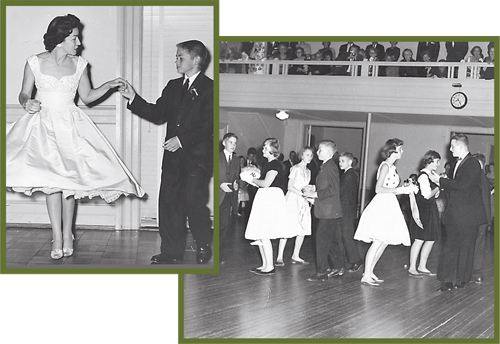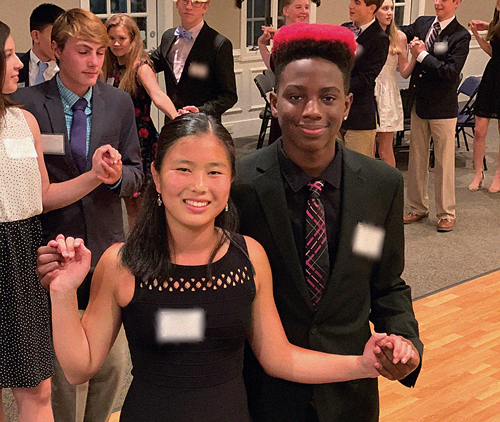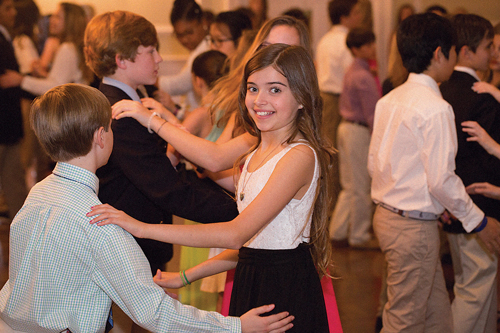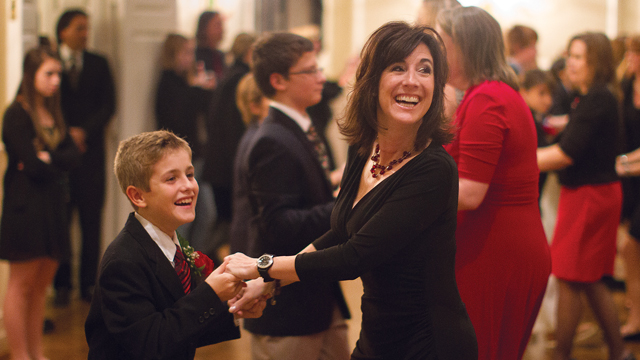As the guests at a party in the opening scene of The Nutcracker, boys and girls dance with one another in formal, synchronized movements, as their parents mingle and watch admiringly from the sidelines.
A similar scene plays out in Richmond every year as two Holly Balls, organized by area cotillion dance programs, bring together middle schoolers in formal attire to dance with one another. Toward the end of the ball, parents are invited to the dance floor, usually receiving instruction from their children on the proper steps.
Area cotillions meet during the school year for dance and social instruction. Participants gather awkwardly with friends and strangers in a large, open space on Friday or Saturday nights, having been driven there by carpooling parents, some of whom linger to take pictures that inevitably make their way to Facebook. The kids’ dress clothes – khakis, jackets, collared shirts, and ties for the boys; bright, knee-length dresses and often, white gloves for the girls – are sourced from department stores, thrift shops, and friends’ closets.
To the uninitiated, the gloves seem anachronistic, but serve a real purpose: They prevent the kids from actually having to touch one another’s hands while dancing.
While dancing is the central activity, representatives of the area’s cotillions are quick to note that lessons go well beyond moving feet in rhythm.
“Junior Assembly Cotillion is a tween and teen coaching partner for parents,” says Liz Stanko, who co-owns JAC with her sister Katherine Byer. “We’re another voice showing our students the best way to conduct themselves. We want students to learn how to treat others with the best possible manners and with respect. Our main goal is social self-confidence, and we use dancing as our tool.”
Suzanne Moncure Hoffman, co-owner of Town & Country Cotillion with Laura Leake Brown, says lessons are practical. “Cotillion is a safe and fun social activity for middle schoolers that also incorporates etiquette through the medium of dancing,” Hoffman says.
Brown adds, “They’re in our room, they’re safe, they’re well-supervised, and they have fun.”
The James River Virginia Chapter of Jack & Jill of America – a national organization focused on fostering leadership development and civic engagement among African American children – sponsors the Richmond Renaissance Junior Cotillion (RRJC), which includes etiquette and communication workshops along with dance lessons.
“The dance itself is a fun production, but the hope is that the workshops teach students to believe they are brilliant, they are poised, and that they can do this in every setting,” says Lenita Wesson, editor and communications chair for the local chapter. “It is important that our kids learn to be strong, compassionate and fully aware of what they are capable of doing and who they are capable of being.”
Following in the Footsteps
Junior Assembly Cotillion traces its history to 1920. Then known as the Junior German – using a term that originated in the mid-1800s to distinguish dancing that is different from the French quadrille – the business changed names and hands over the years. Many lifelong Richmonders remember it as “Miss Donnan’s Cotillion,” named for owner Janet Cleiland Donnan, who was at the helm from 1944 to 1984. Following Donnan’s retirement, Jackie Davidson and Susan Norton expanded the cotillion from Richmond city into Henrico’s West End. Current owners Stanko and Byer are Norton’s daughters and are former cotillion participants themselves.

Town & Country Cotillion was established in 1961 by Brown’s mother and three friends to accommodate growing demand at the time. Brown participated in T&C as a student, worked as a helper when she was older, and watched as her children participated. She became a partner with Hoffman’s mother in 2001 and now works with Hoffman, who also grew up in a cotillion family.
Richmond Renaissance Junior Cotillion was established by the local Jack & Jill chapter in 2012. While both JAC and T&C have families of color participate, Wesson said RRJC’s goal is “to immerse kids in their culture” in an event that is centered on fun activities with kids in the same age range.
Because dancing requires ample space, cotillion is organized into sessions with different times for different grade levels. All students in the same grade from a single school are grouped together, but smaller school populations may be combined. For example, this year, one sixth grade JAC session includes students from Pocahontas Middle, Goochland Middle, and Orchard House.
The cotillion directors say they hope to accept every student who is interested, but space limitations must be observed. They also have to balance the sexes, as girls usually outnumber boys. “Some years, we beg and borrow boys,” Wesson says.
High schoolers may apply to continue on as junior helpers, balancing the numbers as they provide on-the-floor dance instruction themselves. Plus, JAC offers a ninth-grade session for those who aren’t done dancing in eighth grade.
“It’s a 4-year program, in which each year’s instruction builds on what came before,” Stanko says.
Getting the Jitters Out
Mike McCullough, a father of four – the oldest of whom is now in college – participated in cotillion as a teen and is reliving the experience as a parent. He remembers well how he felt as a sixth grader just starting out.
“I was scared and intimidated and one of the short boys,” he says, laughing. “I thought I was going to learn how to dance, but what you realize at some point is that you’re there to learn how to function with other people in a social environment.”
In the beginning, McCullough says, it was the lure of spending an evening with friends that made the event worthwhile. Then, as now, parents will often organize their kids into smaller groups to go out to dinner beforehand or dessert after, depending on the timing of their dance session.
As students arrive for the evening, they pass through a receiving line, where they shake hands, exchange pleasantries, and make eye contact with parent volunteers. The boys and girls then separate on opposite sides of the room, in preparation for the grand march. The dance instructor, standing in the middle, brings the two lines together, pairing students for their first dance. No child has to worry about asking another child to dance.

As the dancing progresses, strategies are used to seamlessly shift partners. Again, no one is left out.
“A lot of students arrive very nervous, but by the end of the evening, they’re all very relieved,” T&C’s Brown says. “Our dance instructor has an amazing sense of humor, which puts them at ease.”
While the notion of cotillion might seem old-fashioned to some, JAC’s Stanko notes that good behavior never goes out of style.
“We reiterate manners and values that parents work so hard on, like proper introductions and treating others with respect and kindness,” she says. “With constant focus on technology and a fear of missing out among this young generation, we are doing everything we can to help our students escape the social, emotional, and technological pressures that are so apparent these days by bringing them one-on-one with each other and teaching them social graces.”
T&C’s Hoffman notes that regular emails sent to parents – as well as reminders on the dance floor – emphasize the importance of eye contact and conversational skills. As middle schoolers, she says, it’s essential for boys and girls to learn how to interact.
McCullough says he appreciates that structure. “As a parent, what I’ve loved is it’s a safe, caring environment for kids to get away from the cell phones and get socially comfortable with their peers,” he says. “To bring middle schoolers into a context where they have to interact with other people – shake hands, look people in the eye – I don’t think that should be underestimated.”

McCullough was a 4-year JAC participant and worked as a junior assistant. His oldest daughter, Mary Katherine, went through the full JAC program and stayed as a helper; son Matthew is a high school junior and is serving as a helper now; and his eighth-grade twin daughters, Allison and Elizabeth, are in their third year.
“Many of the dances are the same and are timeless,” he says. “It’s still a structured environment for people to come and do specific things. The formula works.”
Others agree.
“There are very few programs that exist anymore where boys and girls in their teen years can come together in a safe, organized, and fun environment where they interact with one another away from technology while learning to dance and learning social graces well,” Byer says. “I am passionate about cotillion and its importance and am extremely proud to be a part of this long-standing Richmond organization that is now family- and female-owned and directed.”
RRJC’s Wesson says it’s important to have parents understand that cotillion is a partner in what they do.
“Parents are excited to have their children take part,” she says. “Structure is hard to implement these days. Kids are exposed to so much, so this is good to have.”
Cotillion by the Numbers
Junior Assembly Cotillion
Size: Five sixth-grade groups; two seventh-grade groups; one eighth-grade group; one ninth-grade group
Schedule: Eight dances, including two formal balls (Holly Ball and Cupid’s Ball)
Instructor: Greg Thorp
Locations: Bolling Haxall House and Fox Hall Clubhouse
Cost: $290 for sixth graders; $270 for seventh-ninth graders
Information: juniorassemblycotillion.com
Richmond Renaissance Cotillion
Size: Forty to forty-five students
Schedule: Thirteen sessions (include etiquette luncheon, leadership and communication workshops, dance instruction, formal finale at The Altria)
Instructor: Phyllis Harris
Locations: Spoonbread Bistro, Rigby’s Jig, Altria Theater
Cost: $295 Information: jackandjillrva.org
Town & Country Cotillion
Size: Six sixth-grade groups; three seventh-grade groups; one eighth-grade group
Schedule: Eight dances, including two formal balls (Holly Ball and Valentine)
Instructor: Sandy Yeon
Location: Tuckahoe Woman’s Club
Cost: $295 Information: townandcountrycotillion.com
Cotillion season is roughly October through March, though each group has its own calendar. All cotillions offer need-based financial aid. Information sessions are open to the public. In the spring, parent recruiters reach out to fifth-grade families, offering an invitation to the information sessions for Junior Assembly and Town & Country cotillions. Information for Richmond Renaissance Cotillion is available on their website. No membership in or affiliation with any organization is a prerequisite for participation in any of the cotillions.




